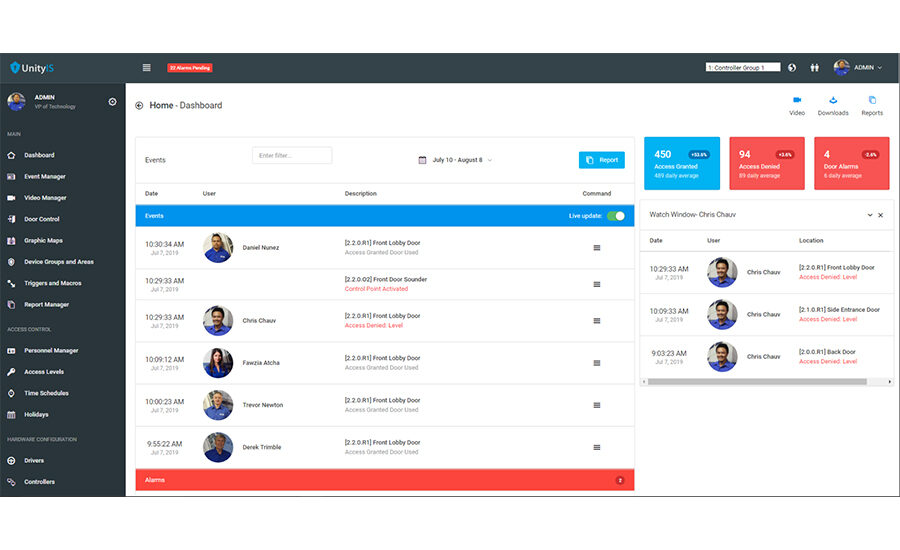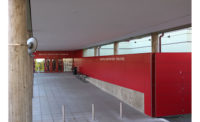Is the cloud-based access control trend finally “hockey sticking?” For several years predictions that cloud will overtake on-premise access control solutions — particularly in the SMB market — have been swirling around the security industry. While that is not likely to happen any time soon, the difference a year makes is particularly evident when it comes to this technology.
“Right now IHS says cloud access is at 20 percent penetration,” says Steve Van Till, president and CEO, Brivo, Bethesda, Md. “I think in three years it will be more like 50 percent and a steady march to 100 percent … I don’t know of any startups in any industry that aren’t using cloud technology. If you think about it that way, the world isn’t giving birth to any more on-premise-based companies. There are no more programmers [being trained] to write that software. It is gradual, but eventually that whole kind of product goes away.”
One key change is end users have begun to realize the advantages of cloud for their security needs.
“Cloud-based platforms are becoming more and more prevalent in the security industry, with so many end users demanding remote accessibility from their security systems,” says Lynn Wood, products portfolio manager, Vanderbilt, Parsippany, N.Y.
“Access control customers have crossed a chasm into accepting cloud-based solutions as a reliable and secure way to provide access control,” says Nolan Mondrow, founder and CEO, RemoteLock, Denver, Colo. “This has been a long time coming and while ‘cloud’ has been a buzzword in the industry for years, we are finally seeing a big acceleration in customer adoption of the technology.”
For security integrators this means a bigger opportunity than ever before. And after a slow start, integrator interest in offering cloud solutions also has picked up.
“Each of the five years I have been at Feenics interest from integrators continues to increase, because they are hearing it from their customers,” says Brian Matthews, director of sales, Feenics Inc., Ottawa, Ontario. “First it was us trying to sell them on it. Now the customer is saying, ‘We want a cloud solution.’ Every year it gets to be more and more of a chorus.”
Despina Stamatelos, product marketing manager for access control, Genetec, Montreal, agrees that while security integrators have been slower to adopt cloud-based solutions, the trend is climbing upward. “It’s slow but we are seeing that the market is asking for it more and more because of end users.” One of the challenges she sees is integrators understanding the sales model.
“We probably get a call a week talking to integrators about best practices in setting up their own hosted environment or adding services to their existing offering,” says Richard Goldsobel, vice president, Continental Access, a division of Napco Security Technologies, Amityville, N.Y.
Van Till says his company has added 400 new dealers in the past year. “The attitude right now is integrators all want a cloud solution in their portfolio.”
More manufacturers continue to introduce cloud-based solutions, whether they are new entrants to the access control space with a cloud-first solution or a more established company making their on-premise solution cloud-friendly.
“I’m very big on getting all the right infrastructure pieces in place, so we just released a brand new complete app for software, which is a critical piece to go along with a cloud-based system … We tailor it so our integrators can host for themselves if they wish to.”
Honeywell now offers a fully integrated cloud-based solution for video, access control and intrusion, says Michael Coniff, senior product marketing manager for SMB solutions, North America, Honeywell Commercial Security, Atlanta. “We look at it as an overall integrated platform, versus just access control … Our biggest leap forward is to bring together into a single platform the ability to manage all three parts of that puzzle for our dealers to provide to our end users.”
From apps to tie-ins with mobile credentials, cloud is opening up a new range of possibilities and features.
Considerations for Choosing A Cloud-Based Access Control Solution
With so many options for cloud-based systems available today (and more coming every day), what are some of the things to consider when choosing which to offer your customers? Here are some thoughts from the experts:
“What may differentiate a real cloud service from just a hosted environment is probably the completeness of the solution, wrapping together ancillary functions and having not just a web client or even an app, but that whole service.” — Richard Goldsobel, Napco Security Technologies
“In deciding who you want to use for cloud-based access, having clarity on the licensing model is important. Keeping that simple and straightforward versus a highly complex model makes a big difference both in selling to the end user and to managing them on an ongoing basis.” — Bill Hogan, D/A Central Inc.
“Bringing on a platform that allows you to stretch and combine [access and video] has some real value and simplicity. It allows you to look at a whole different series of managed services that can be repackaged, whether that is for verification, or dealing with unattended deliveries.” — George Martinez, Johnson Controls
“Some newer vendors in the space might only have feature sets for SMB. Those of us who have been here longer have larger sets of features designed for enterprise.” — Steve Van Till, Brivo
“There are a lot of good solutions out there. I recommend to pick one or two really solid partners in the space that you want to work with and that have a great platform that allows you to outfit as much of the business as you can on one platform. Get really good at them and educate the end users about them.
— Eric Trabold, Nexkey
“Always make sure you understand whether you are actually dealing with a cloud-based platform, or if it’s just a web platform that uses browser-based software. There is a big difference between the two.”
— Brach Bengtzen, ProdataKey
“The cloud access control capabilities and solution set we are introducing first is … cloud-managed mobile credentials,” says George Martinez, director of product management, cloud solutions, Global Security Products, Johnson Controls, Milwaukee. “That is where it starts … You cannot only use cloud to manage issuance and revocation of mobile credentials, but because of cloud capability we could take a reader and use it as a panel-less controller for a door.”
Matthews describes the relationship between cloud and mobile credentials as loosely coupled. “If you are willing to do cloud for access control, the same sort of mindset will also be interested in mobile credentials,” he says.
Mobile access credentials are easy to retrieve from the cloud, says Scott Lindley, general manager, Farpointe Data, Sunnyvale, Calif. “With [our system], mobile access credentials are available to integrators and their customers in exactly the same way that card access credentials have been.”
“Cloud-based access control has been taking a strong turn towards mobile functionality and an increase in integration capabilities,” says Brach Bengtzen, marketing manager, ProdataKey, Draper, Utah. “I foresee cloud-based systems being able to work in conjunction with other platforms to make a singular turnkey option for end users to control and manage HR databases and security in one platform.”
Smartphones figure prominently in the cloud-based solution from Nexkey as well, says Eric Trabold, CEO, Nexkey, San Mateo, Calif. The Nexkey solution combines a reader, panel and controller into one product, as well as an interchangeable core that communicates directly to a mobile phone via the cloud. “We run a Net Promoter Score service and in December we asked, ‘What did you use before Nexkey?’ They used traditional keys,” Trabold reports. “That told us there is a huge greenfield opportunity for cloud-based access control. We talked to a few in more depth to ask why they didn’t use a card or fob before. They were hesitant because of the cost and management of server-based software. They were all waiting for something that can be managed easily with a smartphone or browser with minimal effort.”
While much of the talk about cloud-based access control revolves around the SMB space, a growing trend is an increase in interest from enterprise customers, as well.
“Larger and larger clients are saying, ‘We want to get away from managing servers and software,’” says integrator Bill Hogan, president and CEO, D/A Central Inc., Oak Park, Mich. “Larger clients are looking for a hosted solution because their IT departments are not managing servers. They are putting as much in the cloud as possible.”
This is something Genetec has been seeing for the past few years, Stamatelos says. “A lot of customers that have on-premise systems are ready to go to cloud. Even talking to new customers, when you are talking about access control they are looking at it from a cloud perspective because IT is much more involved in the decision-making process and they want to take solutions to the cloud.”
Van Till has also seen an uptick in enterprise interest. “Our dealer channel continues to sell lots of SMB,” he says. “That is their bread and butter. Eighty percent of businesses in the U.S. are SMB addresses so it is logical that is everyone’s biggest segment. But we have seen growth of 20 percent on the enterprise side. We intersected our customers with the Fortune 500 list and found 200 of them are customers.”
Cloud access control continues to get more popular with most segments of end users, and there are several good reasons for that.
Beyond the IT push to the cloud, demographics and experiences are also changing, Coniff says. “Owners of businesses are changing. The age level of CEOs is changing. “They think, ‘My credential should work everywhere.’ As end users look to solve the operational ease of use, simplicity, globalization, etc., cloud will inherently become part of that solution.”
Mondrow adds, “Increasingly access control customers are personally experiencing the capabilities of IoT smart locks. Access control is no longer about putting the same kind of lock on every door. When the only tool in the toolbox is a hammer, everything is a nail. When the only tool in the integrator’s toolbox was a panel, every door got the same solution. Now, customers who have smart locks at home … expect the right tool for each individual door, all at a cost proportional to their security and complexity … I truly believe that cloud-based access, particularly the direct cloud control of wireless locks, will be one of the biggest drivers of growth in access control in the coming years.”
Subscription models in general are the wave of the future, Hogan says. “There won’t necessarily be a change in the traditional vendor structure, but all the manufacturers recognize this is where they have to be. They also want to have a model that allows them to reinvest in their platforms and software and the only way that works is with a subscription-based model … [That] is the future and cloud is the perfect answer for that with access control because access control doesn’t require a lot of large storage or heavy data.”
Beyond that, cloud is helping manufacturers and integrators provide more secure solutions to more customers. “What cloud platforms are allowing us as manufacturers to do is you have a bunch of intelligence that can be collectively managed and deployed in the cloud,” Martinez says. “That allows us to provide a level of security at the edge you wouldn’t be able to do without cloud. Now you can just use a reader to control locally without a network because you are using the power of the cloud to push smart keys to a mobile phone. From an integrator’s perspective that allows them to go to markets that are much more price-sensitive or where traditional technology wouldn’t allow the customer to secure those points. It allows us to reach a different set of economics and secure more with less.”
Cloud access and subscription models lower the creation cost of a solution.
“What our research has shown is when a dealer makes a proposal to a customer, the number one reason they fail to get the business is the customer has sticker shock,” Van Till says. “Imagine you have three or four doors of access control and you think that should cost around $1,000. The average price per door [with an on-premise system] is still $2,500 and that kind of freaks them out. They want security but they don’t want it that bad. With cloud, the cost of entry is much lower. It gets rid of the up-front cost because you got rid of the server, the labor to set it up and the software licenses.”
Longer term, some predict the cloud will enable even more advanced functionality and some of the top emerging trends from IoT to AI. “If history is any indication, as things moved to the mobile computing environment from the desktop, so too will cloud-based move to more mobile-managed systems,” says Peter Boriskin, chief technology officer, Americas, ASSA ABLOY Americas, New Haven, Conn. “When we look at the sort of industrial Internet of Things you see devices becoming more and more web-service friendly and leveraging standards-based solutions … The barrier to entry will be lowering along that path, as well.”
Advice From an Integrator
SDM spoke with integrator Bill Hogan of D/A Central Inc. to ask about his company’s experiences with offering cloud-based access control.
SDM: How and why did you first start offering cloud-based access control?
Hogan: We got into the cloud-based access world about five years ago when we first started and have had a variety of different clients we have built out a cloud-based access system for. We do a lot of enterprise-level integration and, as a result of that, most of what we do is still traditional access control. However, we know this is the future and we are trying to stay on the front edge of it.
SDM: How do you go about choosing a solution?
Hogan: Everybody wants to have a cloud-based offering. Some are more integrator-friendly than others. That makes a big difference on the selection we make and our offerings to our clients. We have been traditionally a big Lenel house and they are in the process of rolling out a cloud version of OnGuard. That makes a lot of sense for us. However, for other new greenspace opportunities, we also look at cloud-first, true cloud rather than something hosted in the cloud — something designed with very different architecture. I think there are advantages to that and they have been pretty nimble.
SDM: What is the biggest advantage to offering cloud-based access control as an integrator?
Hogan: We started with just one two-door system and that morphed into multiple sites. One of the opportunities for this is if you have many smaller sites it makes these systems very cost-effective and easy to manage across dozens of sites. I also think for this generation of IT managers, this is what they are looking for. If you bring them a traditional access control solution they are saying, “Why are you giving me an old school solution?”
The other big advantage of a cloud-based access control system is the ability to constantly upgrade the software and firmware and all of those pieces. People don’t always understand the advantage you get with a cloud-based solution. You are almost making changes on a rolling basis.
SDM: What advice would you give your fellow integrators on offering cloud?
Hogan: Pretty much every company will have to have their own cloud-based solution to be competitive. That is where the market is going whether they like it or not.
Jason Bryan, director of sales, 3xLOGIC, Fishers, Ind., adds, “As cloud applications grow in access control, the market will move toward identity management versus door management. We are moving to the use of AI and machine learning to enable frictionless access control and the only way to accomplish that is with cloud-based systems.”
For security integrators, the number one reason to consider cloud-based access control is, of course, RMR. But transitioning to that model isn’t always easy. Other challenges include reaching new customers and markets, and communicating the benefits of cloud-based access to customers who aren’t already demanding it. When done well, however, adding one or more cloud-based access control solutions to your portfolio can open new business opportunities.
“The best part of this story is the opportunity for integrators to use a cloud-based access control system as a means to increase revenue, not only from the RMR they will receive, but also from the ability to easily offer managed access for the customer,” Mondrow says. “With this model, integrators can bundle in several services like maintenance contracts, warranties, managed access, reports from system data, etc. All of this increases RMR for integrators.”
For integrators still reluctant to try cloud, Matthews advises not to overthink it, and suggests not doing it will have worse consequences. “If they don’t jump in they will be the ones sitting there with a bunch of analog cameras getting laughed out of an office,” he says, referencing the change from analog to IP cameras that caught some integrators off guard a few years ago. “They may not know how to do it, but really it is very little change. You are still selling an install … You are still selling all the components, just not the server and software. There is some fear and misunderstanding, but you can’t shy aware from it forever. It is not a completely different business model. It is like 10 percent different.”
Now is a particularly good time to be addressing cloud with customers, Martinez says. “There are a lot of customers that have legacy systems that are in a refresh cycle. A lot of them are up against their digital transformation strategies and evaluating cloud and software-as-a-service solutions from an economic perspective.”
Security is sometimes the only department not in the cloud yet, Matthews adds, making it an even better opportunity. “Integrators need to at least ask the customer if they are interested in cloud. Because if they aren’t having that conversation, somebody else is.”
Boriskin advises stressing the Op Ex/Cap Ex distinction to cloud. He also suggests targeting internal doors of existing customers. “If you think of the typical building, maybe 15 percent of doors are perimeter and 85 percent are interior. If you even take another 10 percent to 15 percent of doors in that building you are basically doubling the available doors for access control. It is a tremendous opportunity for providing access and auditability and accountability..”
Security integrators have a key role to play in the transition to cloud, says Fawzia A. Atcha, Ph.D, vice president, IMRON Corp. “As more customers are aware of these options, the integrators could then start leading with the cloud solution and eventually on-premise would be completely replaced … Until then, cloud [solutions] should be a part of their portfolio as a primary offering.”
More Online
For more on cloud-based access control visit SDM’s website, where you will find the following articles:
“3 Reasons You Should Be Offering Cloud-Based Access Control”
www.SDMmag.com/reasons-you-should-be-offering-cloud-based-access-control
“The State of the Access Control Market in 2019”
www.SDMmag.com/state-of-the-market-access-control-2019
“How to Find Managed Access Success”
www.SDMmag.com/how-to-find-managed-access-success
“What Do You Know About Cloud-Based Access Control?”
www.SDMmag.com/what-do-you-know-about-cloud-based-access-control







